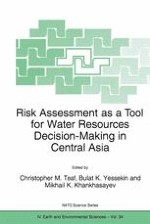2004 | OriginalPaper | Buchkapitel
Radioactive Contamination of Aquatic Ecosystems: Source, Transfer and Countermeasures
verfasst von : C. M. Vandecasteele
Erschienen in: Risk Assessment as a Tool for Water Resources Decision-Making in Central Asia
Verlag: Springer Netherlands
Enthalten in: Professional Book Archive
Aktivieren Sie unsere intelligente Suche, um passende Fachinhalte oder Patente zu finden.
Wählen Sie Textabschnitte aus um mit Künstlicher Intelligenz passenden Patente zu finden. powered by
Markieren Sie Textabschnitte, um KI-gestützt weitere passende Inhalte zu finden. powered by
Continental waters represent a key natural resource for the socio-economic development and welfare of human communities. However, because of its numerous uses for domestic, agricultural, industrial and recreational purposes, freshwaters are perhaps the most sensitive natural resource as almost all activities listed above contribute to degrade and pollute it. In the last centuries as well as to this day, the development of human populations and activities have required steadily increasing amounts of water, resulting in a general increase of the degradation of water quality of many rivers, lakes, and aquifers. Surface and underground waters are potential sources of populations exposure to technologically enhanced naturally occurring radioactive material and artificial radioactivity. Direct exposure can be associated with the consumption of drinking water or foodstuffs (i.e., fish, shellfish, aquatic plants, etc.) but also with leisure and sport activities such as fishing and swimming. Indirect human exposure arises from the use of river waters for irrigation and watering of livestock or from the use of algae or sludges as soil amendments. This paper reviews the potential sources of freshwater contamination by natural and artificial radioactivity. It further describes the radiological exposure pathways of humans and discusses the feasibility and effectiveness of potential countermeasures to prevent exposure above acceptable limits.
